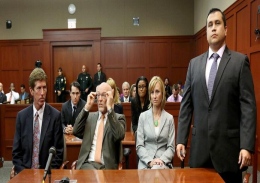When George Zimmerman received his “not guilty” verdict Saturday, a case that had touched Ohio State’s campus — about 1,000 miles from the crime scene in Sanford, Fla. — was wrapped up.
Neighborhood watch leader Zimmerman fatally shot 17-year-old Trayvon Martin on Feb. 26, 2012. Zimmerman was tried for second-degree murder and manslaughter. He said the shooting was in self-defense.
About a week after the shooting, vandals spray-painted the words “Long Live Zimmerman” on the side of the Frank W. Hale Jr. Black Cultural Center on OSU’s campus. The painted words were discovered the morning of April 5, 2012, on the west exterior wall of Hale Hall.
The act of vandalism was dubbed a hate crime by campus officials.
The incident started a ripple effect of protests, including a sit-in against the vandalism by students and faculty. Similar hate speech was found painted near campus one day later, and roughly a week later a task force was formed to combat hate on campus.
While no suspects have been identified in the spray-painting of Hale Hall, leaving their race, possible OSU affiliation, gender and age unknown, the incident showed the far-reaching effects of the shooting in Florida.
The case has received national attention since the shooting happened, with largely mixed reactions to the incident, the trial and the final verdict. Some people across the country and on OSU’s campus have responded passionately.
Katy Dilts, a fourth-year in women’s studies, said she was frustrated by the verdict.
“I have been following the trial since I heard about it,” Dilts said, “and I thought for sure that Zimmerman was going to be convicted. I’m frustrated he wasn’t even convicted of manslaughter, which can be a charge in even accidental murder cases.
“Zimmerman did it, but it seems like he doesn’t have to atone for his actions, which seems unfair to me.”
Zach Zaerr, a third-year in finance, said he felt relieved by the verdict.
“I think it’s awful someone lost their life. I don’t think anyone, even those who say they were on Zimmerman’s side, were happy about that,” Zaerr said. “But in the end I think justice won out.”
President Barack Obama released a statement Sunday, in which he called the death of Martin a tragedy, “not just for his family, or for any one community, but for America.” The statement said that while the verdict might heighten passions, “a jury has spoken.”
“I now ask every American to respect the call for calm reflection from two parents who lost their young son,” Obama said. “And as we do, we should ask ourselves if we’re doing all we can to widen the circle of compassion and understanding in our own communities. We should ask ourselves if we’re doing all we can to stem the tide of gun violence that claims too many lives across this country on a daily basis. We should ask ourselves, as individuals and as a society, how we can prevent future tragedies like this.
“That’s the way to honor Trayvon Martin.”
Zaerr said he followed the case closely from the beginning and thinks Obama brought the case extra attention by commenting on it.
“(Obama) brought it to a national level and turned it into a race thing. Even though Zimmerman is Hispanic, he was described as being ‘white-Hispanic,’ making it about race,” Zaerr said. “It was set up for a negative reaction once the verdict was announced, and it was made worse by attention from the media and the president.”
Nick Schlie, a fourth-year in strategic communication, said he thought the trial was fair.
“A lot of the jury members had sons, so they could relate to the feeling of a mother’s pain,” Schlie said.
He said the second-degree murder charge and different witness accounts complicated the trial.
“In the end it was hard to convict with a second-degree murder charge. I think Zimmerman was in the wrong but a second-degree charge was bold,” Schlie said. “And when eyewitnesses were telling different stories it can be hard to prove what happened. So if you can’t prove it, it’s hard to convict.”
Zaerr agreed.
“No one knows for sure what happened that night. And no one knows more than the jury. The trial was as fair as possible,” he said. “You can only go off of as much as you can gather.”
Joe Curmode, a member of OSU’s mock trial team and a third-year in sociology and political science, though, said he was not surprised Zimmerman was acquitted.
“I’d known for a while that he’d be found not guilty, because there was not enough evidence and there would need to be lesser charges (than second-degree murder),” Curmode said.
He also thought aspects of the case were blown out of proportion.
“It’s an example of people being outraged over a crime that they think is racist when there are actually much more racist things happening every day,” Curmode said. “The jury did what they should in a court of law: look at the facts and uphold what the facts could prove.”
Dilts said she hopes the attention the case grabbed leads to larger conversations about justice in America.
“I can really see where the protests (following the announcement of the verdict) are coming from,” Dilts said. “I really do feel it was a wrong call, and it’s indicative of a larger problem in this country. We shouldn’t be done talking about these things.”



